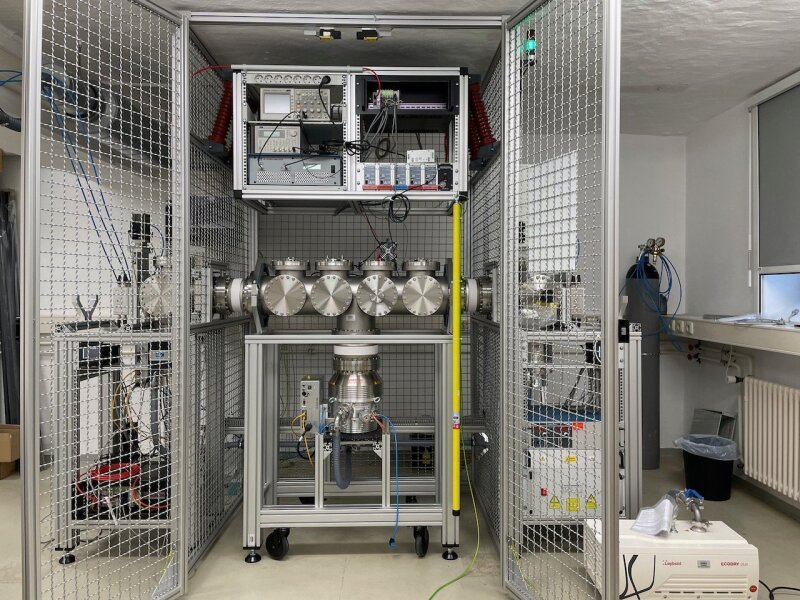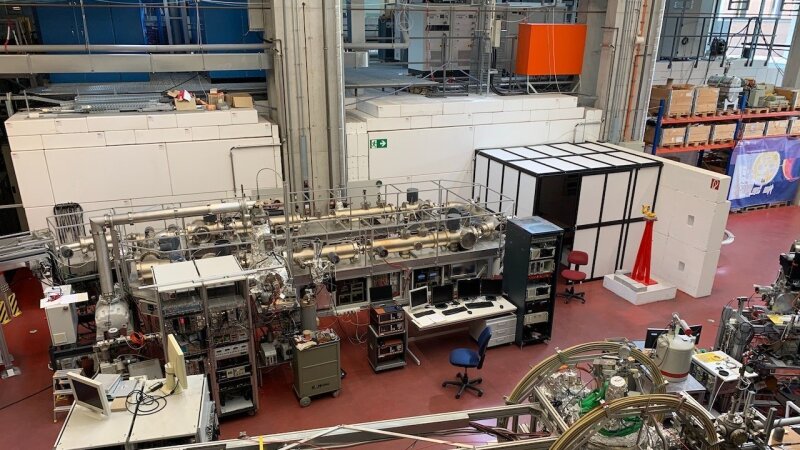Laser Irradiation of Negative Ions
Project participants:
O. Forstner1,2, Thomas Weber2, Vadim Gadelshin3, Klaus Wendt3, Kurt Stiebing4
1Helmholtz-Institut JenaExternal link
2Institut für Optik und Quantenelektronik, Friedrich-Schiller-Universität Jena de
3Institut für Physik, Johannes-Gutenberg-Universität MainzExternal link
4Institut für Kernphysik, Goethe-Universität FrankfurtExternal link
A neutral atom or molecule can pick up an extra electron resulting in a negative ion. Because the nuclear charge of a neutral atom is fully screened, only a polarization of the electron shell can provide the necessary binding. However, this strongly depends on the electronic configuration – and is not possible for all elements. Nitrogen e.g., does not form negative ions (that’s why radiocarbon dating with accelerators works so well).
Negative ions find broad applications in accelerator mass spectrometry (AMS). A major limitation of any mass spectrometer is the presence of isobars. As isobars have nearly the same mass, but completely different electronic configurations the spectroscopic properties of the corresponding negative ions differ. With the help of lasers this effect can be used to suppress unwanted isobars. A laser photon of a certain wavelength can detach the additional electron and therefore neutralize the negative ion. To reach the necessary high efficiencies high interaction densities are required. This can be achieved by slowing the ions to thermal energies in a cooler device before the laser interaction and afterwards re-accelerate them.
In the framework of the BMBF funded collaborative project 05K2019 – LISEL@DREAMS a radio-frequency ion cooler is built at the FSU Jena. After completion it will be installed at the AMS facility DREAMS am HZDRExternal link. Our collaboration partner at the University of Mainz builds a tunable, high-repetitive Ti:sapphire laser system. Together both systems allow the element selective suppression of isobars by laser photodetachment. This enables the use of new isotopes at DREAMS and an expansion of the application spectrum.
The radio-frequency ion cooler for efficient interaction of negative ions with laser photons.
Image: O. ForstnerAn important property of negative ions is the binding energy of the extra electron – known as electron affinity (EA). To detach the extra electron a laser photon needs at least that energy. The EA can be precisely determined using tunable lasers and scanning the laser wavelength until the detachment takes place, i.e., until the ion neutralizes. For atomic negative ions this can be done quite easily – for molecular negative ions the internal degrees of freedom must be considered (rotation, vibration, …). While keeping the negative ion in a storage ring the internal states can be reduced by cooling, which leads to a more precise determination of the EA. These studies are going to be performed at the low-energy storage ring FLSR at the Goethe-University in Frankfurt/Main. The laser radiation is there coupled into the ring vacuum via special vacuum windows and interacts with the stored ions. The neutralized atoms are no longer being stored and can be detected after leaving the storage ring.
Electrostatic storage ring at the Goethe-University Frankfurt. On the right of the ring the newly constructed laser hut can be seen. The laser beam will be guided in tubes along the wall to the ring, where it is coupled into the ring vacuum by vacuum windows.
Image: O. ForstnerIn a collaboration with colleagues from Göteborg determinations of the electron affinity of radioactive ions are being performed. To achieve this negatively charged radioactive ions are produced at CERN-ISOLDEExternal link in Geneva and further overlapped with a laser beam. In this way the electron affinity of a radioactive ion (128I−) could be measured for the first time. Subsequently, the electron affinity of astatine could be determined. Astatine is the rarest element on earth [3]. In the near future measurements of isotope shifts of the electron affinity of radioactive ions are going to be performed [5].
Referenzen
[1] O. Forstner et al., Nucl. Instr. Meth. B 361, 217 (2015)External link
[2] O. Forstner et al., Hyp. Int. 241, 53 (2020)External link
[3] D. Leimbach et al., Nat. Comm. 11, 3824 (2020)External link
[4] S. Rothe et al., J. Phys. G 44, 104003 (2017)External link
[5] ISOLDE-Proposal: Measurement of shifts in the electron affinities of chlorine isotopesExternal link

